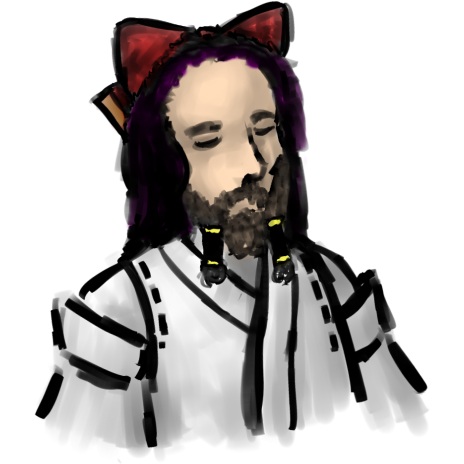- 📝 Posted:
- 🚚 Summary of:
- P0190, P0191, P0192
- ⌨ Commits:
5734815...293e16a,293e16a...71cb7b5,71cb7b5...e1f3f9f- 💰 Funded by:
- nrook, -Tom-, [Anonymous]
- 🏷 Tags:
The important things first:
- TH05 has passed the 50% RE mark, with both
MAIN.EXEand the game as a whole! With that, we've also reached what -Tom- wanted out of the project, so he's suspending his discount offer for a bit. - Curve bullets are now officially called cheetos! 76.7% of
fans prefer this term, and it fits into the 8.3 DOS filename scheme much
better than homing lasers (as they're called in
OMAKE.TXT) or Taito lasers (which would indeed have made sense as well). - …oh, and I managed to decompile Shinki within 2 pushes after all. That left enough budget to also add the Stage 1 midboss on top.
So, Shinki! As far as final boss code is concerned, she's surprisingly economical, with 📝 her background animations making up more than ⅓ of her entire code. Going straight from TH01's 📝 final 📝 bosses to TH05's final boss definitely showed how much ZUN had streamlined danmaku pattern code by the end of PC-98 Touhou. Don't get me wrong, there is still room for improvement: TH05 not only 📝 reuses the same 16 bytes of generic boss state we saw in TH04 last month, but also uses them 4× as often, and even for midbosses. Most importantly though, defining danmaku patterns using a single global instance of the group template structure is just bad no matter how you look at it:
- The script code ends up rather bloated, with a single
MOVinstruction for setting one of the fields taking up 5 bytes. By comparison, the entire structure for regular bullets is 14 bytes large, while the template structure for Shinki's 32×32 ball bullets could have easily been reduced to 8 bytes. - Since it's also one piece of global state, you can easily forget to set
one of the required fields for a group type. The resulting danmaku group
then reuses these values from the last time they were set… which might have
been as far back as another boss fight from a previous stage.
 And of course, I wouldn't point this out if it
didn't actually happen in Shinki's pattern code. Twice.
And of course, I wouldn't point this out if it
didn't actually happen in Shinki's pattern code. Twice.
Declaring a separate structure instance with the static data for every
pattern would be both safer and more space-efficient, and there's
more than enough space left for that in the game's data segment.
But all in all, the pattern functions are short, sweet, and easy to follow.
The "devil"
pattern is significantly more complex than the others, but still
far from TH01's final bosses at their worst. I especially like the clear
architectural separation between "one-shot pattern" functions that return
true once they're done, and "looping pattern" functions that
run as long as they're being called from a boss's main function. Not many
all too interesting things in these pattern functions for the most part,
except for two pieces of evidence that Shinki was coded after Yumeko:
- The gather animation function in the first two phases contains a bullet group configuration that looks like it's part of an unused danmaku pattern. It quickly turns out to just be copy-pasted from a similar function in Yumeko's fight though, where it is turned into actual bullets.
- As one of the two places where ZUN forgot to set a template field, the
lasers at the end of the white wing preparation pattern reuse the 6-pixel
width of Yumeko's final laser pattern. This actually has an effect on
gameplay: Since these lasers are active for the first 8 frames after
Shinki's wings appear on screen, the player can get hit by them in the last
2 frames after they grew to their final width.
Of course, there are more than enough safespots between the lasers.
Speaking about that wing sprite: If you look at ST05.BB2 (or
any other file with a large sprite, for that matter), you notice a rather
weird file layout:

And it's not a limitation of the sprite width field in the BFNT+ header
either. Instead, it's master.lib's BFNT functions which are limited to
sprite widths up to 64 pixels… or at least that's what
MASTER.MAN claims. Whatever the restriction was, it seems to be
completely nonexistent as of master.lib version 0.23, and none of the
master.lib functions used by the games have any issues with larger
sprites.
Since ZUN stuck to the supposed 64-pixel width limit though, it's now the
game that expects Shinki's winged form to consist of 4 physical
sprites, not just 1. Any conversion from another, more logical sprite sheet
layout back into BFNT+ must therefore replicate the original number of
sprites. Otherwise, the sequential IDs ("patnums") assigned to every newly
loaded sprite no longer match ZUN's hardcoded IDs, causing the game to
crash. This is exactly what used to happen with -Tom-'s
MysticTK automation scripts,
which combined these exact sprites into a single large one. This issue has
now been fixed – just in case there are some underground modders out there
who used these scripts and wonder why their game crashed as soon as the
Shinki fight started.
And then the code quality takes a nosedive with Shinki's main function.
![]() Even in TH05, these boss and midboss update
functions are still very imperative:
Even in TH05, these boss and midboss update
functions are still very imperative:
- The origin point of all bullet types used by a boss must be manually set to the current boss/midboss position; there is no concept of a bullet type tracking a certain entity.
- The same is true for the target point of a player's homing shots…
- … and updating the HP bar. At least the initial fill animation is abstracted away rather decently.
- Incrementing the phase frame variable also must be done manually. TH05 even "innovates" here by giving the boss update function exclusive ownership of that variable, in contrast to TH04 where that ownership is given out to the player shot collision detection (?!) and boss defeat helper functions.
- Speaking about collision detection: That is done by calling different functions depending on whether the boss is supposed to be invincible or not.
- Timeout conditions? No standard way either, and all done with manual
ifstatements. In combination with the regular phase end condition of lowering (mid)boss HP to a certain value, this leads to quite a convoluted control flow. - The manual calls to the score bonus functions for cleared phases at least provide some sense of orientation.

- One potentially nice aspect of all this imperative freedom is that
phases can end outside of HP boundaries… by manually incrementing the
phase variable and resetting the phase frame variable to 0.

The biggest WTF in there, however, goes to using one of the 16 state bytes
as a "relative phase" variable for differentiating between boss phases that
share the same branch within the switch(boss.phase)
statement. While it's commendable that ZUN tried to reduce code duplication
for once, he could have just branched depending on the actual
boss.phase variable? The same state byte is then reused in the
"devil" pattern to track the activity state of the big jerky lasers in the
second half of the pattern. If you somehow managed to end the phase after
the first few bullets of the pattern, but before these lasers are up,
Shinki's update function would think that you're still in the phase
before the "devil" pattern. The main function then sequence-breaks
right to the defeat phase, skipping the final pattern with the burning Makai
background. Luckily, the HP boundaries are far away enough to make this
impossible in practice.
The takeaway here: If you want to use the state bytes for your custom
boss script mods, alias them to your own 16-byte structure, and limit each
of the bytes to a clearly defined meaning across your entire boss script.
One final discovery that doesn't seem to be documented anywhere yet: Shinki actually has a hidden bomb shield during her two purple-wing phases. uth05win got this part slightly wrong though: It's not a complete shield, and hitting Shinki will still deal 1 point of chip damage per frame. For comparison, the first phase lasts for 3,000 HP, and the "devil" pattern phase lasts for 5,800 HP.
And there we go, 3rd PC-98 Touhou boss
script* decompiled, 28 to go! 🎉 In case you were expecting a fix for
the Shinki death glitch: That one
is more appropriately fixed as part of the Mai & Yuki script. It also
requires new code, should ideally look a bit prettier than just removing
cheetos between one frame and the next, and I'd still like it to fit within
the original position-dependent code layout… Let's do that some other
time.
Not much to say about the Stage 1 midboss, or midbosses in general even,
except that their update functions have to imperatively handle even more
subsystems, due to the relative lack of helper functions.
The remaining ¾ of the third push went to a bunch of smaller RE and finalization work that would have hardly got any attention otherwise, to help secure that 50% RE mark. The nicest piece of code in there shows off what looks like the optimal way of setting up the 📝 GRCG tile register for monochrome blitting in a variable color:
mov ah, palette_index ; Any other non-AL 8-bit register works too.
; (x86 only supports AL as the source operand for OUTs.)
rept 4 ; For all 4 bitplanes…
shr ah, 1 ; Shift the next color bit into the x86 carry flag
sbb al, al ; Extend the carry flag to a full byte
; (CF=0 → 0x00, CF=1 → 0xFF)
out 7Eh, al ; Write AL to the GRCG tile register
endm
Thanks to Turbo C++'s inlining capabilities, the loop body even decompiles
into a surprisingly nice one-liner. What a beautiful micro-optimization, at
a place where micro-optimization doesn't hurt and is almost expected.
Unfortunately, the micro-optimizations went all downhill from there,
becoming increasingly dumb and undecompilable. Was it really necessary to
save 4 x86 instructions in the highly unlikely case of a new spark sprite
being spawned outside the playfield? That one 2D polar→Cartesian
conversion function then pointed out Turbo C++ 4.0J's woefully limited
support for 32-bit micro-optimizations. The code generation for 32-bit
📝 pseudo-registers is so bad that they almost
aren't worth using for arithmetic operations, and the inline assembler just
flat out doesn't support anything 32-bit. No use in decompiling a function
that you'd have to entirely spell out in machine code, especially if the
same function already exists in multiple other, more idiomatic C++
variations.
Rounding out the third push, we got the TH04/TH05 DEMO?.REC
replay file reading code, which should finally prove that nothing about the
game's original replay system could serve as even just the foundation for
community-usable replays. Just in case anyone was still thinking that.
Next up: Back to TH01, with the Elis fight! Got a bit of room left in the cap again, and there are a lot of things that would make a lot of sense now:
- TH04 would really enjoy a large number of dedicated pushes to catch up with TH05. This would greatly support the finalization of both games.
- Continuing with TH05's bosses and midbosses has shown to be good value for your money. Shinki would have taken even less than 2 pushes if she hadn't been the first boss I looked at.
- I've got a new idea for 📝 properly linking in master.lib and getting rid of the 32-bit build step… (Edit (2022-05-31): Nope, that didn't work out after all.)
- Oh, and I also added Seihou as a selectable goal, for the two people out there who genuinely like it. If I ever want to quit my day job, I need to branch out into safer territory that isn't threatened by takedowns, after all.
